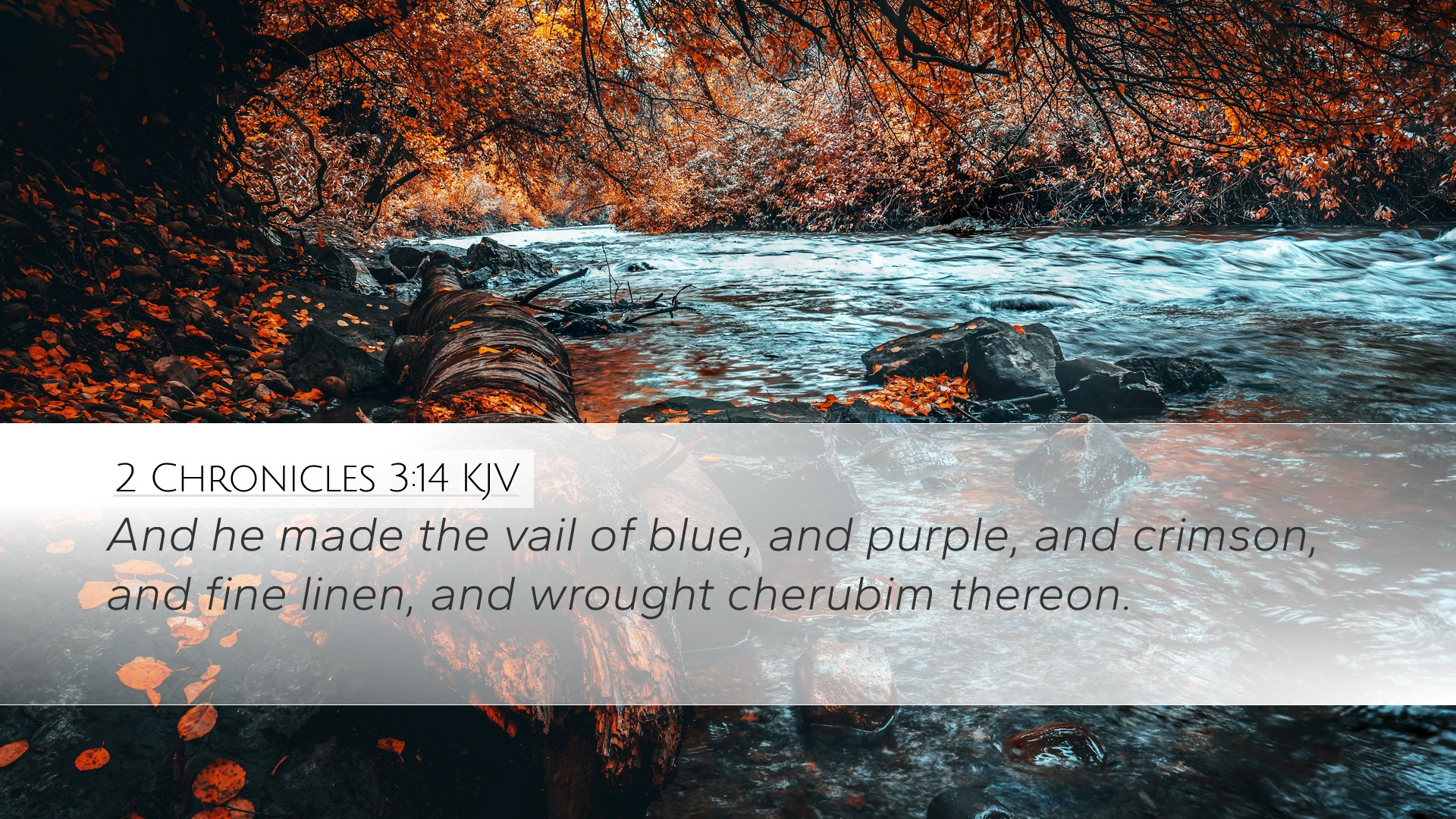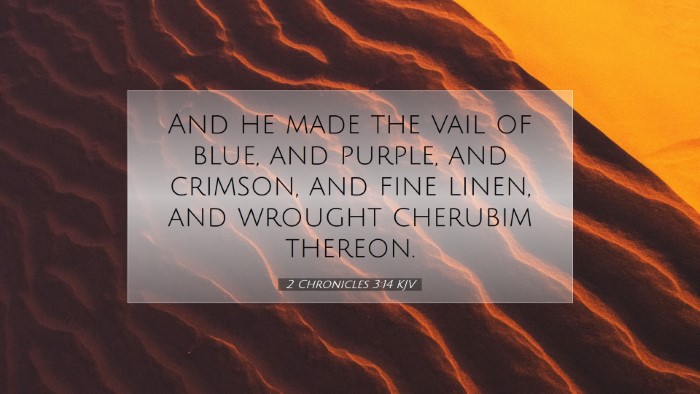Commentary on 2 Chronicles 3:14
Text of the Verse:
"And he made the vail of blue, and purple, and crimson, and fine linen, and wrought cherubims thereon."
(2 Chronicles 3:14, KJV)
Introduction
The construction of the temple, particularly in the account of 2 Chronicles, serves as an essential theme showcasing God's presence and His covenant with Israel. 2 Chronicles 3:14 highlights a crucial aspect of the temple—the veil—symbolic of separation and sanctuary, rich in theological implications and artistic detail.
Historical Context
Under King Solomon's reign, the building of the temple in Jerusalem represented a significant fulfillment of God’s promises to David and a focal point of Israel's worship. This passage focuses on the veil, which acts as a divider between the Holy Place and the Most Holy Place, embodying the transcendent holiness of God and His approachability to humanity.
Analysis of the Verse
The Construction of the Veil
The text specifies that the veil was made of blue, purple, and crimson with fine linen. Each color carries significant symbolism:
- Blue: Traditionally associated with heaven and the divine.
- Purple: Signifies royalty and the majesty of God.
- Crimson: Represents sacrifice and atonement, indicative of the blood of Christ.
The fine linen reflects purity and holiness, emphasizing the nature of God as set apart from sin and imperfection.
Wrought Cherubims
The mention of cherubims upon the veil adds another layer of meaning. Cherubim are heavenly beings often depicted as guardians of God's holiness. They serve as a reminder of God's presence and the reverence due to Him:
- Theological Implication: The ornamentation of the veil with cherubim symbolizes both God's majesty and the protective aspect of His holiness.
- Connection to Eden: The imagery recalls the cherubim placed at the entrance of the Garden of Eden (Genesis 3:24), reinforcing the idea of access to God being restricted due to sin.
Theological Significance
Veil as a Symbol of Separation
The veil plays a pivotal role in the temple's architecture, symbolizing the separation between God and mankind. The use of vibrant colors and elaborate design expresses the beauty and gravity of God's holiness:
- The separation caused by sin must be acknowledged, calling attention to the need for an intermediary.
- Jewish understanding emphasizes that only the high priest could enter the Most Holy Place once a year, indicating the veil's critical function in managing the relationship between God and His people.
Fulfillment in Christ
With the advent of Christ, the significance of the veil transformed dramatically:
- His death on the cross is marked by the tearing of the temple veil (Matthew 27:51), signifying direct access to God for all believers.
- The elaborate nature of the veil is contrasted by the simplicity and the profound sacrifice of Jesus, who fulfills the requirement for atonement.
Insights from Commentaries
Matthew Henry
According to Henry, the construction details reflect the magnificence of the temple. He emphasizes that the veil's excellence points to the grandeur of God and encapsulates the deep reverence that should accompany our worship.
Albert Barnes
Barnes notes that the colors used not only denote beauty but also serve as reminders of the heavenly realities and the depths of the redemptive story. He emphasizes the notion of 'wrought' cherubims, which indicates a careful craftsmanship reflecting the seriousness of the sacredness of God's dwelling.
Adam Clarke
Clarke provides a rich discussion on the fabric and artistry of the veil, interpreting it as a representation of God's glory and the relational dynamics between God and His people. He draws attention to the significance of the veil leading to profound theological truths about God's nature and the human condition.
Conclusion
2 Chronicles 3:14 encapsulates a rich tapestry of theological themes—God’s holiness, the necessity for atonement, and the promise of access through Christ. For pastors, students, and theologians, the verse stands as a reminder of the incredible grace that Christians now enjoy, allowing direct communion with the divine through Jesus. This profound shift from the veil to the open access we have today invites all believers to approach God with confidence, acknowledging both His majesty and His mercy.


